Last Chance to Catch NYC's Holiday Notalgia Train
We met the voices of the NYC subway on our nostalgia ride this weekend!

![First Pieces of New York Wheel Are Installed on Staten Island [Photos]](/content/images/size/w100/wp-content/uploads/2016/12/new-york-wheel-staten-island-ferris-wheel-construction-site-pedestal-installation-nyc-040.jpg)

Yesterday, we witnessed the installation of the first pieces of the New York Wheel, to be the world’s largest ferris wheel when opened to the public in Spring 2018 on the north shore of Staten Island. The 100 ton pedestals arrived a month ago by barge from Quebec, crossing the locks of the Erie Canal and down the Hudson River over the course of 315 miles. Although the pedestals were within the weight limits for New York State, they were too heavy for the roads and bridge of Quebec – hence its fitting, watery passage here to New York City.
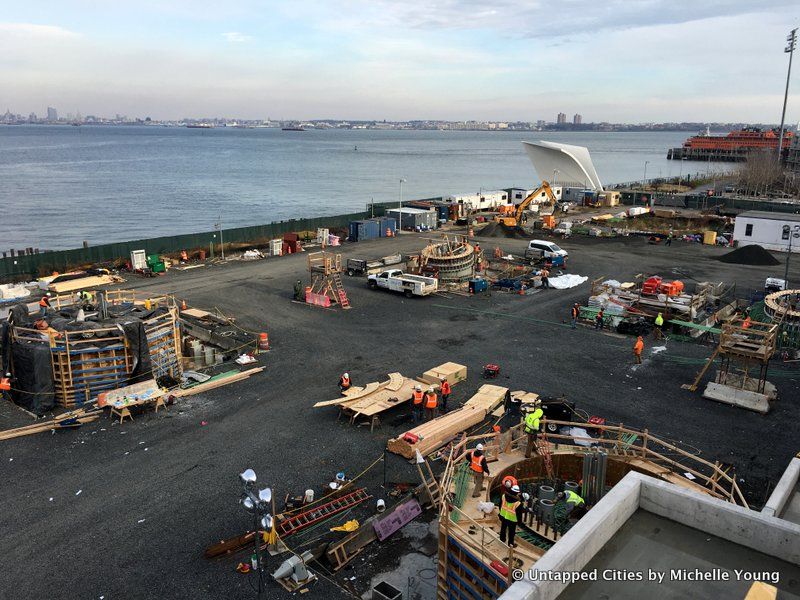
The construction of the New York Wheel is a true multi-national, multi-borough, and multi-firm feat. The wheel is an economic driver that has already brought $26 million in Staten Island-based work. Within the $1.2 billion project to redevelop the north shore of Staten Island, the New York Wheel constitutes $590 million of that investment. It is expected to bring in three million visitors per year. Just next door, the SHoP Architect-designed Empire Outlets is rising quickly.
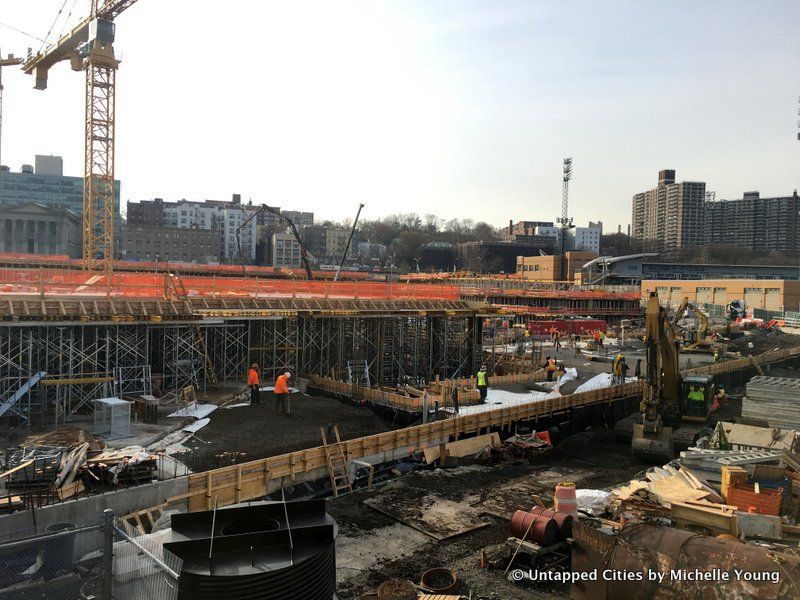
Construction at Empire Outlets
The pedestals, built by ADF Group in Quebec, are eighteen feet in diameter and fitted on site with 96 epoxy coated embedded bolts which have to be torqued at precise angles so that the wheel’s 275 foot legs, which arrived in October from Italy to the South Brooklyn Marine Terminal, will rise at the correct angles next month. It was an ideal time to visit the site, because each of the four pedestals were in different stages of completion. As New York Wheel CEO Richard Marin pointed out, it was an important point yesterday, where we could “memorialize [the project] at the cusp of transition of the pedestals…It’s a challenging thing to build, very expensive and very intricately engineered.”
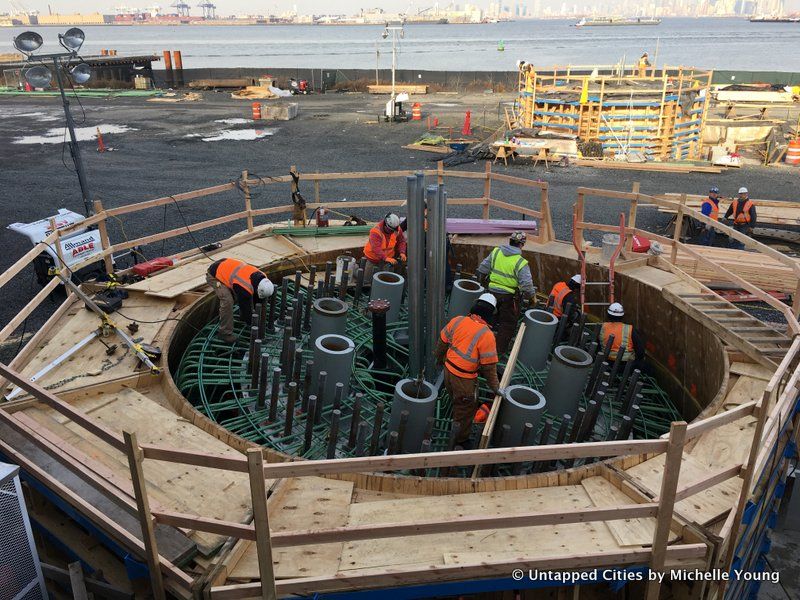
The first pedestal was already encased in 11 feet of concrete, poured in the morning and setting within a $110,000 wooden form that will be reused on its mirror image pedestals diagonally across. The concrete takes two days to set. A second was being prepared for concrete, with the metal rebars already installed around the pins and the wooden form installed. The third pedestal was mid-process with the rebar fitting and we watched the workers shape the long metal bars into place. On the fourth pedestal, the bolts were still being installed.
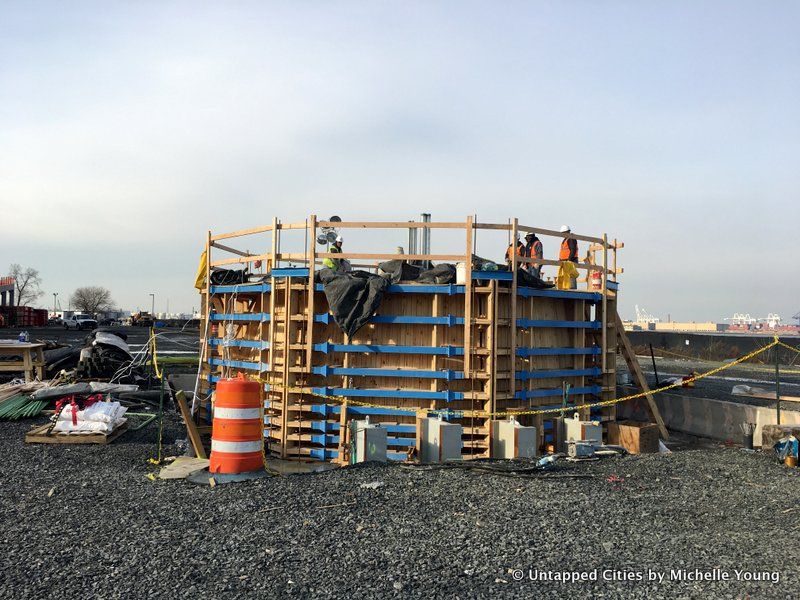
Pedestal where concrete has already been poured, encased in wooden form
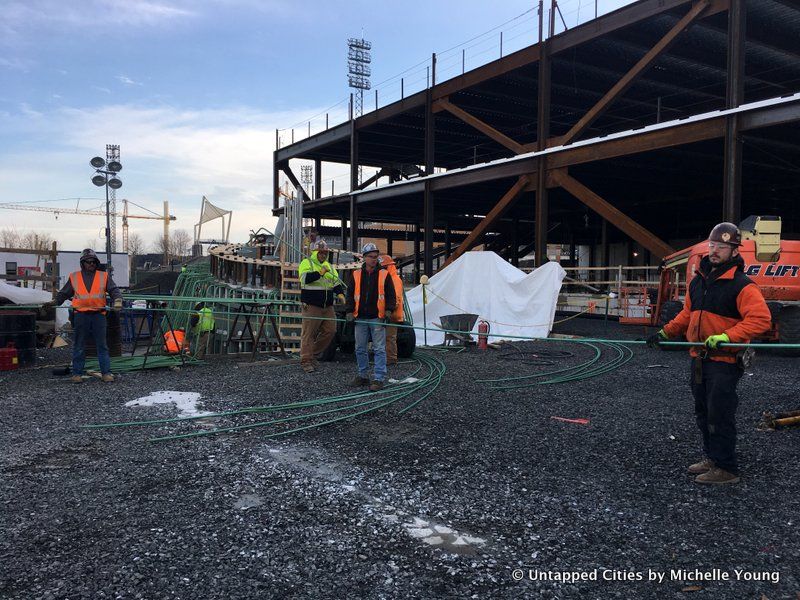 Workers about to shape the rebars
Workers about to shape the rebars
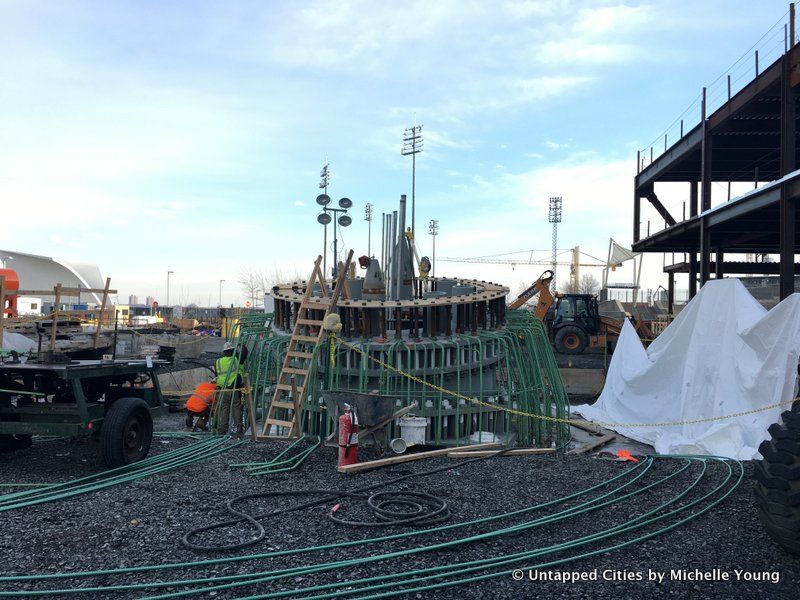
Underground however, is even more complex and the firm Skanska, who has worked on high profile infrastructure projects in New York City for nearly a century, including most recently the Second Avenue Subway, World Trade Center (original and new), LaGuardia Airport and Moynihan Station, was responsible for all the engineering under the hood at the New York Wheel. The land along the waterfront has been a challenge to work with and Michael Viggiano, EVP and lead of Skanska’s civil engineering group for the northeast region, told the group, “It’s really an engineering marvel underground” and that the New York Wheel stood out even amongst its portfolio of projects. To ensure the stability of the wheel, it has been built with what architect Navid Maqami of S9 Architecture, the design principal for the New York Wheel with Perkins Eastman, describes as “stilettos heels” that go deep down into the bedrock.
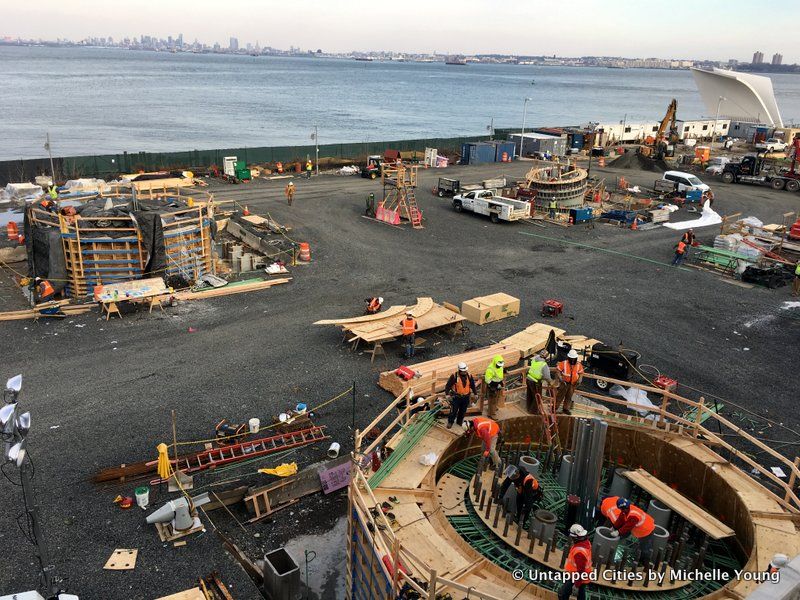
A temporary dock, built at the tune of $3 million by Staten Island firm Reicon Group LLC, has enabled the delivery of these large pieces of the New York Wheel. The next items to come will be two mega cranes, one over 465 feet high. Both are currently stored in pieces at the South Brooklyn Marine Terminal and will cross the New York Harbor as soon as the pedestals are completed. The cranes can lift 1300 tons at at time and require two feet thick steel spreader mats to stabilize the machinery so that the crane beds do not shift.
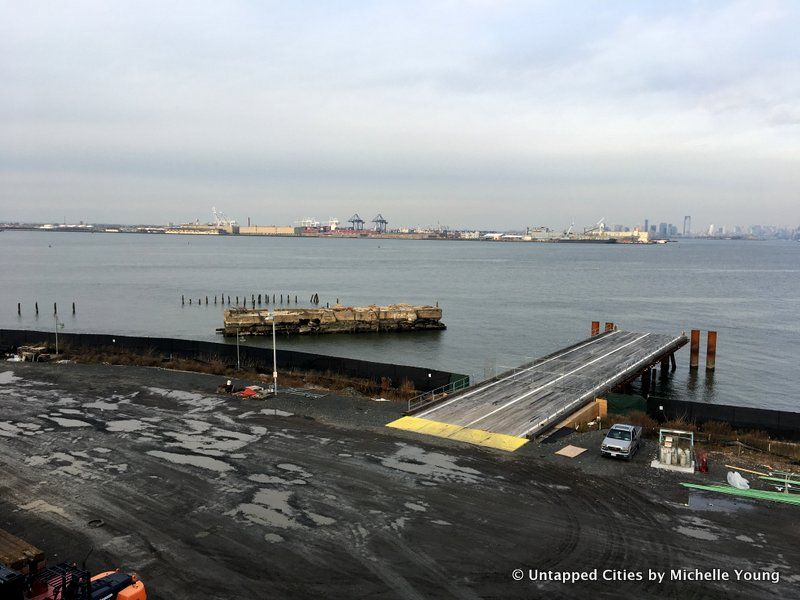
Temporary dock
The legs will then by shipped over from the Marine Terminal in January and installed onto the pedestals and a gantry built between the legs. Four mass dampers, similar to large swimming pools, will be installed atop the legs temporarily to keep vibration down until the spindle and other pieces of the wheel are installed.

Legs arriving to the South Brooklyn Marine Terminal
The terminal building and garage structure behind the New York Wheel will host two green roofs covering a total of five acres. With the staircase just poured, we were among the first people to ever walk up the steps. The main structure of this building, in pre-cast concrete is in place, awaiting a curtain wall skin of terra cotta fins. Parking, currently by valet only, is already open with 660 spaces of self parking to open up later.
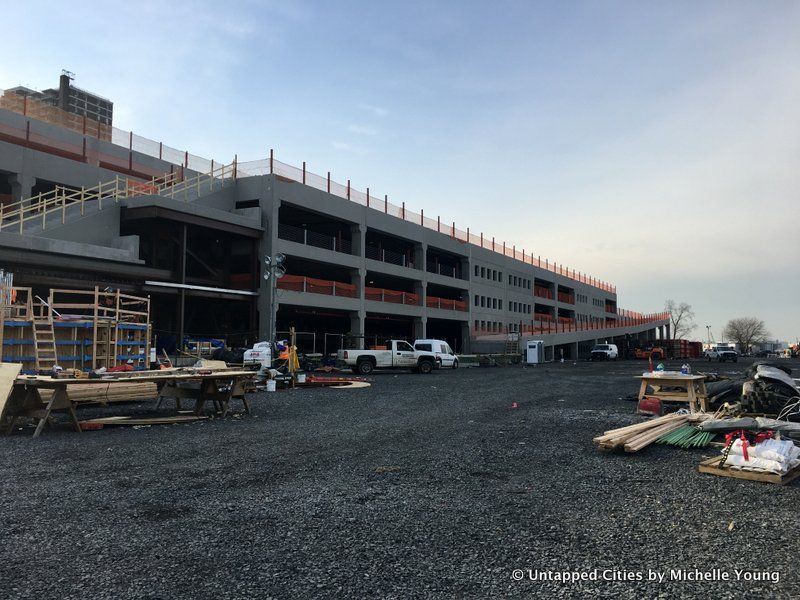
Terminal and garage building

One level of the future green roof
Council Member Debi Rose told the group, “There isn’t until there’s something above ground that you can see that adds to the reality of it…This is helping put Staten Island on the map.” Assemblyman Matthew Titone spoke to the renaissance of the north shore of Staten Island that the New York Wheel and accompanying projects would bring.

View of Richmond County Ballpark, home to Staten Island Yankees, the Staten Island 9/11 Memorial, and Staten Island ferry terminal

View to skyline of Manhattan and Brooklyn
Staten Island Borough President James Oddo added, “with the delivery of the pedestals they have now reached another milestone, which means we will soon see the Wheel begin to rise. That brings us a step closer to the completion of what I believe will be one of the most identifiable icons of New York City. I don’t think it’s hyperbole to say that in the not-too-distant future when folks think of New York City, the New York Wheel will stand proudly alongside icons like the Empire State Building and Statue of Liberty.” Also on the tour was Laurent Waessa of the Government of Québec in New York, who ceremonially delivered the pedestals to the site.
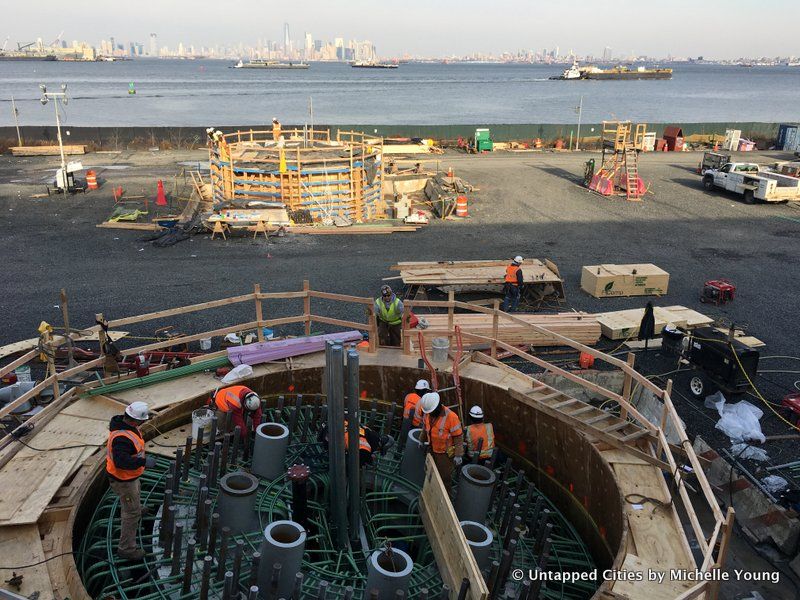
Still to come, the arrival of the 36 capsules which will be able to host 1440 people per ride. Stay tuned for more Behind the Scenes updates on the construction of the New York Wheel on Untapped Cities. You can also see the construction live on Earthcam here.
Next, see photos of the arrival of the legs of the New York Wheel.
Subscribe to our newsletter